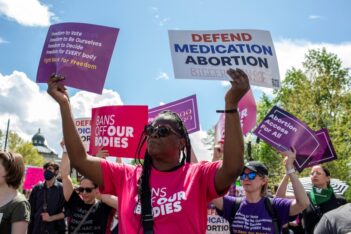
Changes to Title X regulations could reduce low-income patients’ access to reproductive health care.
For nearly 50 years, Title X of the Public Health Service Act has been the sole federal program devoted to funding family planning services for low-income and underinsured communities. The Trump Administration’s changes to Title X regulations, however, could restrict access to vital family planning services for communities that need them the most.
Title X has funded counseling on a variety of family planning care and alternatives, including abortion. Since the program’s inception, however, clinics have been prohibited from using federal funds they receive from Title X for performing abortions. In addition to counseling, Title X-funded clinics also offer contraceptives, STI testing, and some primary care services.
The Trump Administration’s regulations require Title X clinics to maintain “a physical and financial separation” between abortion procedures and Title X-funded services. To remain compliant with these changes while continuing to offer abortion counseling and procedures, clinics would need an additional space physically separate from where they offer existing Title X family planning services. In practice, however, the cost of creating such a space is prohibitive. Clinics instead face an impossible choice: Providers must either limit the scope of their services or continue to offer abortion services but decline further funding from Title X.
The regulations also impose what critics describe as a “gag rule” that bars clinicians from providing referrals to abortion clinics or mentioning abortion—even when the patient requests the information. Physicians from groups such as the American Medical Association criticize the gag rule because it “restricts them from providing complete information to patients about all of their health care options and providing appropriate referrals for care.”
Although pro-life advocates celebrate the Trump Administration for diverting funds from clinics that provide abortion services, critics argue that the regulations deprive patients of access to the full range of reproductive care. Critics also claim that the Administration’s changes shrink the network of available providers for communities that rely on Title X for family planning services.
Because of the economic, practical, and ethical burdens that these regulations impose, several Title X clinics have announced plans to exit the program. This exodus could leave millions of patients without access to essential health care under Title X.
Though the incoming Biden Administration may alter Title X and moot the present controversies, 23 states’ attorneys general, multiple family planning organizations, and several individual physicians have filed lawsuits challenging the Trump Administration’s regulations.
This week’s Saturday Seminar explores the role of Title X and potential consequences of the Trump Administration’s regulations on access to family planning services.
- In a working paper with the National Bureau of Economic Research, Martha J. Bailey of the University of California Los Angeles, Olga Malkova of the University of Kentucky, and Zoe M. McLaren of the University of Maryland, Baltimore County argue that access to federal family planning programs allows parents to provide better economic opportunities for their children. Children born after the introduction of family planning programs, Bailey, Malkova, and McLaren found, possessed more economic advantages than those born before these programs. These improvements in socioeconomic stability, they suggest, result from family planning programs such as Title X that encouraged young parents to build strong educational and professional foundations before starting their families.
- Policymakers must reverse attempts to cut Title X funding to ensure access to basic health care, Rachel Benson Gold, formerly of the Guttmacher Institute, and Enterprise Community Partners’s Kinsey Hasstedt argue in an American Journal of Public Health article. “Eliminating Title X would deal a devastating blow to safety-net family planning providers and the communities who rely on them,” according to Gold and Hasstedt. Citing statistics from 2015, the authors claim that Title X’s family planning services prevented 278,000 abortions that year by helping avoid 822,000 unintended pregnancies. Gold and Hasstedt also highlight the financial benefits of Title X and suggest that cutting the program is “short-sighted.”
- Why should Title X clinics offer patients comprehensive pregnancy counseling and services? Harvard University’s Elizabeth Janiak, Wellesley College’s Jennifer O’Donnell, and University of California San Francisco’s Kelsey Holt argue that “patients who rely on Title X-funded services deserve the same standard of care as their wealthier neighbors with private insurance coverage.” They argue that the Trump Administration’s changes to Title X impose obstacles on patients seeking high quality, patient-centered care because these changes prevent providers from offering “full-spectrum pregnancy options counseling” and referrals for prenatal or abortion services. Instead, the authors advocate federal policy that effectively responds to all patient preferences, including abortion.
- The Trump Administration’s changes to Title X could prevent adolescent patients from receiving confidential reproductive services without their parents’ permission, Naomi Schapiro of the University of California San Francisco School of Nursing argues. In a recent Journal of Pediatric Health Care article, Schapiro claims that requiring parental notification for contraceptives does not deter adolescents from engaging in sexual activity—instead, it makes them less likely to seek out reproductive care. Schapiro suggests that the regulations could place minors at greater risk for STDs and unintended pregnancies.
- In a working paper, economists Andrea Kelly of Grinnell College, Jason Lindo of Texas A&M University, and Analisa Packham of Vanderbilt University analyze the effects of an effort to fund Title X clinics to make long-acting reversible contraceptives (LARCs) “available to low-income women for free or at reduced costs.” LARCs, such as the intrauterine device and the contraceptive implant, are more than 99 percent effective at preventing pregnancy, provide protection for years, and require no action from the patient after implantation. Kelly, Lindo, and Packham found that among teenagers that lived within seven miles of a Title X clinic taking part in the initiative, births fell by about 20 percent. The authors encourage policymakers to expand access to free and reduced-cost LARCs through Title X, because reducing unintended pregnancies improves patients’ “ability to invest in their high school and post-high-school education” as well as their economic circumstances later in life.
- Because Title X restricts access to abortion, primary care physicians not associated with the Title X program should offer medication abortion, University of California San Francisco’s Jessica Beaman and Dean Schillinger claim in a New England Journal of Medicine article. Medication abortion, also known as the “abortion pill,” is a non-surgical procedure that ends a pregnancy through oral medicine rather than a surgical procedure. Beaman and Schillinger note that although the U.S. Food and Drug Administration approved the medical abortion pill mifepristone for consumers in 2000, the United States lags behind several European countries in the percentage of first trimester medication abortions. This difference may be due to the popularity of medication abortion in rural European communities and the higher cost of medication abortion compared to surgical abortion in the United States.
The Saturday Seminar is a weekly feature that aims to put into written form the kind of content that would be conveyed in a live seminar involving regulatory experts. Each week, The Regulatory Review publishes a brief overview of a selected regulatory topic and then distills recent research and scholarly writing on that topic.



